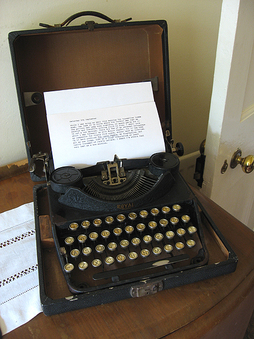 I am always fascinated by the physical ways that people write, by the technologies they choose or don't choose. There is a Royal typewriter at the Kilns, but C. S. Lewis never used it. In fact, he never learned to type at all. He wrote long hand in school exercise books and used an ink-pen that he had to dip in an inkwell--very messy and impractical. Apparently Mr.s Moore hated the inkwell, which he sometimes knocked over and spilled. But stopping to dip the pen in the well was an important part of his writing rhythm. It forced him to pause. In those pauses, he gathered his thoughts, he read the words out loud to himself (and he could hear the words without the interference of tip tapping) and he did recursive editing in his head. Lewis wrote quickly and usually did not take things through a second draft. The ink pen was the only thing that slowed him down. In this way he was the opposite of Tolkien, who composed very slowly, wrote multiple drafts and typed and retyped them himself often to save money. Overwhelmed with the expenses of having a family, he couldn't afford to pay a typist. Of course, Jack's typist was very conveniently his brother Warnie. As an army Officer in Charge of Supplies Warnie would have had to spend many hours in front of a typewriter, filling out forms. He apparently typed very fast although he only used two fingers. And he believed wholeheartedly in his brother and his genius. Typing Jack's papers and correspondence gave him a purpose and was much more fulfilling than typing forms for the army. In addition to never learning to type, Jack never learned how to drive. The scenes of him diving in Shadowlands are pure Hollywood. He loved to walk. He often walked all the way home to Headington from Oxford. He famously became convinced of the truth of Christianity while walking with Tolkien and Hugo Dyson. He took long walking tours with his brother and with other Inklings. On these tours the men would discuss philosophy, religion, and literary criticism. Somehow the movement of their legs, the rhythm of their steps would facilitate the movement of their thoughts. Thought and language are inseparable and rhythm is important to both. The Royal typewriter captures beautifully the relationship between the two brothers. It captures their different personalities; Warnie's more technological bent, his love of machines, boats, train and Jack's literary leanings, his absorption in pre-modern worlds and fantasy. It illustrates their dependence on one another. Warnie needed Jack to keep him away from alcohol, loneliness, depression. Jack needed Warnie to ground him, to remind him of his childhood and to help him type his manuscripts and organize his immense correspondence. NOTES FOR WRITERS AND TEACHERS OF WRITING
First of all, artifacts like the Royal typewriter are great sources of inspiration, great triggers for one's own writing. The Royal typewriter gave me the idea to write a book about C.S. Lewis using the angle of his friendship with his brother. Second of all, it is always good to be aware of the technologies that help us or hurt us while we are writing. What did we use when we first learned to write? What is habitual for us? Does our writing come out differently if we write a draft long hand before transitioning to the typewriter? And when we choose a technology, how much do sound, rhythm and timing matter? Computers give us the ability to compose at lighting speed, but is that always good? Do we loose the sound or sense of what we are writing if we go too fast?
9 Comments
http://www.nytimes.com/2015/10/12/opinion/the-importance-of-recreational-math.html?_r=0 It’s funny for me to be writing a blog post in response to an article about recreational math. I am after all the most mathematically challenged person in the universe. My children realized by about fourth grade that they had already surpassed me. When students ask what they need to make on a test to get an A in my class, I tell them they will have to do that math themselves. But enough about my math challenges. I was surprised to see in the article the name Martin Gardner and to discover that he was famous in the math world for creating elaborate puzzles. I, of course, know Martin Gardner as the editor of the annotated Alice in Wonderland. And it makes perfect sense that as a mathematician, Martin Gardner would be interested in Lewis Carroll. Lewis Carroll taught mathematics and logic at Oxford.
But the more important connection between Gardner and Carroll is their love of puzzles and play, their belief that learning should be fun. Perhaps if I had played more mathematical games, I would have less trouble now adding up my students’ grades. And I certainly hope, as the article suggests, that recreational mathematics will find a place in the Common Core. http://www.theguardian.com/books/2015/oct/23/jrr-tolkien-middle-earth-annotated-map-blackwells-lord-of-the-rings I was thrilled and intrigued to read about this new discovery of Tolkien “ephemera” as Blackwells calls it. The map reveals many of the reasons I love Tolkien. First of all, it shows how much his imagination was visual as well as textual and linguistic. He was a happy man with a sketch pad and a set of ink pens; his artwork helped feed his writing and vice versa. Consider the careful details that went into just the imaginary postage stamps on his Father Christmas letters. Just the lettering itself on the stamps is beautiful. Tolkien understood that text could be art and art could be text.
The discovery also reveals his love of maps, which Bilbo Baggins shared with him. “He loved maps, and in his hall there hung a large one of the country round with all his favorite walks marked on it in red ink.” Maps were integral to Tolkien’s fantasy worlds, to his plots, to his writing process. As writers we could all learn from him to do more mapping. And most importantly of all, the detailed annotations reveal his scholarly, curmudgeonly insistence on perfection. They reveal his desire to control how his work was printed and transmitted down to the smallest minutiae. Hooray for Tolkien! What a great find! In the early hours of the morning of May 22, 1867 Charles Dodgson worked feverishly on a one-hundred line poem that opposed the Vice-Chancellor of Oxford’s Decree of April 29 calling for the conversion of a park in North Oxford into a cricket pitch. The poem he wrote is a parody of Oliver Goldsmith’s “The Deserted Village” (1770). It should not surprise us that Dodgson framed his protest in this parodic form, but why did he care, what did he have against the sport of cricket, and what can we learn from this controversy about his conception of childhood? First of all, he laments the artificial levelling of the naturally rolling grounds of the park. Adown thy glades, all sacrificed to cricket, Thy hollow-sounding bat now guards the wicket; Sunk are thy mounds in shapeless level all, Lest aught impede the swiftly rolling ball; And trembling, shrinking from the fatal blow, Far, far away thy hapless children go. The destruction of this natural space has displaced its natural inhabitants, children. In the romantic tradition, Dodgson identifies children here as a part of nature and as vulnerable to Victorian “progress.” But the children he describes are not privileged drawing room children like Alice Liddell, daughter of the Dean of Christ Church College, but “urchins.” He deplores the loss of the “charms” belonging to, The never-failing brawl, the busy mill Where tiny urchins vied in fistic skill-- (Two phrases only have that dusky race Caught from the learned influence of the place; Phrases in their simplicity sublime, “Scramble a copper!” “Please, Sir, what’s the time?”) These round thy walks their cheerful influence shed; These were they charms—but all these charms are fled. A man of his age and an essentialist, Dodgson conflates race and class when he refers to the unwashed, coal smudged children as “that dusky race.” But more importantly he idealizes the freedom of the brawling, fighting “urchins” whom he considers much closer to nature than the drawing room child. This idealization helps to explain why he photographed Alice barefoot dressed as a beggar. Supervised by her governess, Miss Prickett, and shuffled between lessons and fittings by her ambitious mother, Alice could only pretend to be a child of nature.
Of course it is deeply problematic to idealize and prettify childhood poverty, but Dodgson was on to something in opposing the overly structured lives of middle and upper class Victorian children. In a letter to May Forshall, one of his child friends, he wrote: “Do you ever play at games? Or is your idea of life “breakfast, lessons, dinner, lessons, tea, lessons, bed, lessons, breakfast, lessons,” and so on? It is a very neat plan of life and almost as interesting as being a sewing machine or a coffee grinder.” Just the word coffee grinder evokes images of Dickens’ Mr. Gradgrind stuffing facts down little childrens’ throats and destroying their imaginations. When he asks Miss Forshall if she plays at “games,” Dodgson does not mean exclusive, organized sports like cricket, which he associates with wealth and privilege. Ill fares the place, to luxury a prey, Where wealth accumulates, and minds decay; Athletic sports may flourish or may fade, Fashion may make them, even as it has made; But the broad Parks, the city’s joy and pride, When once destroyed can never be supplied! Rather he means the kind of imaginative games that children invent on their own, games without “pavilions” and “scorers’ tents,” games without winners and losers, games without complicated and absurd rules. Dodgson was obsessed with childhood and children because they represented for him freedom from the oppressive constraints of Victorian life. They represented freedom from finicky indoor spaces, freedom from ticking wristwatches, freedom from attention to manners and dress, and finally freedom from the burdens of his academic work. |
Caroline McAlisterCaroline is an avid reader, children's writer, and teacher. She lives in North Carolina with her husband and dog. Check out her bio for more! Archives
February 2024
Categories
All
|
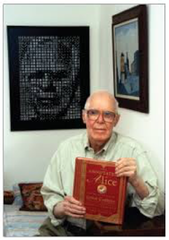
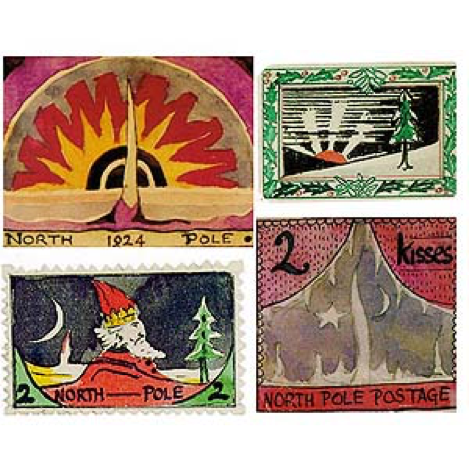

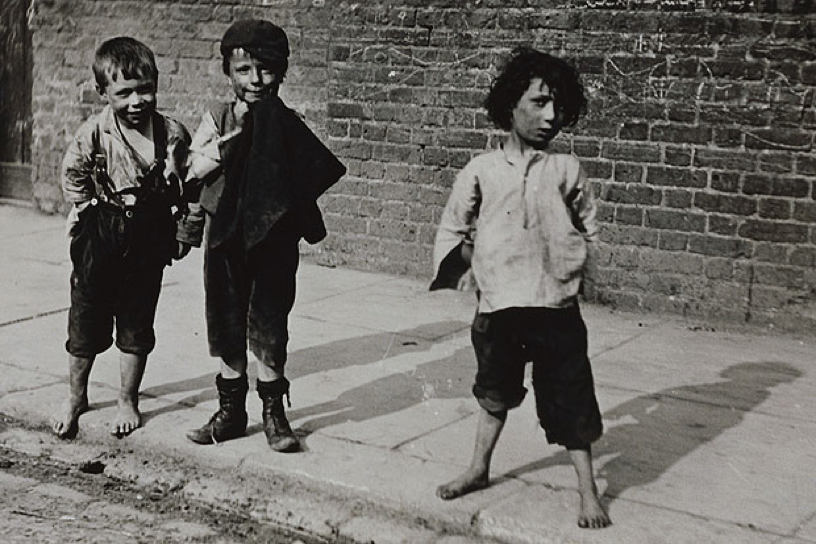
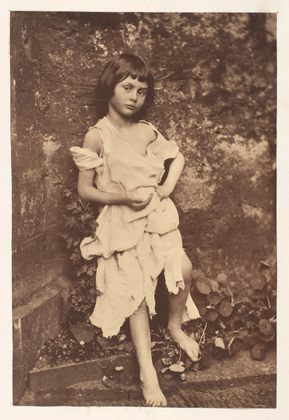
 RSS Feed
RSS Feed